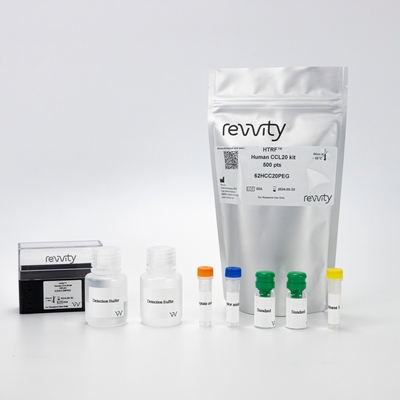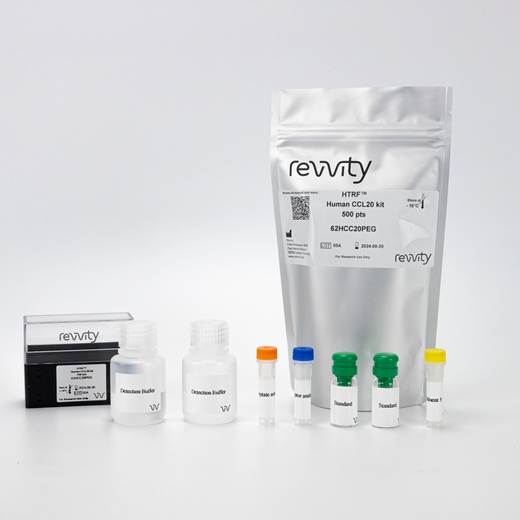

HTRF Human CCL20 Detection Kit, 500 Assay Points


HTRF Human CCL20 Detection Kit, 500 Assay Points






The HTRF human CCL20 (MIP3 alpha) kit is designed for the quantification of human CCL20 release in cell supernatant.
For research use only. Not for use in diagnostic procedures. All products to be used in accordance with applicable laws and regulations including without limitation, consumption and disposal requirements under European REACH regulations (EC 1907/2006).
| Feature | Specification |
|---|---|
| Application | Protein Quantification |
| Sample Volume | 16 µL |
The HTRF human CCL20 (MIP3 alpha) kit is designed for the quantification of human CCL20 release in cell supernatant.
For research use only. Not for use in diagnostic procedures. All products to be used in accordance with applicable laws and regulations including without limitation, consumption and disposal requirements under European REACH regulations (EC 1907/2006).



HTRF Human CCL20 Detection Kit, 500 Assay Points



HTRF Human CCL20 Detection Kit, 500 Assay Points



Product information
Overview
Also called LARC (liver activation regulated chemokine) or MIP3A (macrophage inflammatory protein 3), CCL20 is a chemokine mainly present in peripheral blood lymphocytes, lymph nodes, and the liver. CCL20 secretion is upregulated by microbial factors and inflammatory cytokines like TNFa or IFNg. Its main role is to attract lymphocytes and dendritic cells to the site of infection. In the CNS, CCL20 released by endothelial cells has been shown to attract TH17 cells and promote their infiltration to the lumbar spinal cord.
Specifications
| Application |
Protein Quantification
|
|---|---|
| Brand |
HTRF
|
| Detection Modality |
HTRF
|
| Product Group |
Kit
|
| Sample Volume |
16 µL
|
| Shipping Conditions |
Shipped in Dry Ice
|
| Target Class |
Cytokines
|
| Target Species |
Human
|
| Technology |
TR-FRET
|
| Therapeutic Area |
Neuroscience
Oncology & Inflammation
|
| Unit Size |
500 Assay Points
|
Video gallery

HTRF Human CCL20 Detection Kit, 500 Assay Points

HTRF Human CCL20 Detection Kit, 500 Assay Points

How it works
Assay principle
Cell supernatant, sample, or standard is dispensed directly into the assay plate for the detection by HTRF® reagents (384-well low-volume white plate or Revvity low-volume 96-well plate in 20 µl). The antibodies labeled with the HTRF donor and acceptor are pre-mixed and added in a single dispensing step, to further streamline the assay procedure. The assay can be run up toa1536-well format by simply resizing each addition volume proportionally.

Assay data analysis
The 4 Parameter Logistic (4PL) curve is commonly recommended for fitting an ELISA standard curve. This regression enables the accurate measurement of an unknown sample across a wider range of concentrations than linear analysis, making it ideally suited to the analysis of biological systems like cytokine releases.
Revvity also worked with Myassays.com to help you in your data analysis.
Assay details
Technical specifications of human CCL20 kit
| Sample size | 16 µL |
|---|---|
| Final assay volume | 20 µL |
| Kit components | Lyophilized standard, frozen detection antibodies, buffers &protocol. |
| LOD &LOQ (in Diluent) | 15 pg/mL &47 pg/mL |
| Range | 47 – 2,000 pg/mL |
| Time to result | ON at RT |
| Species | Human only |
Analytical performance
Intra and inter assay
Intra-assay (n=24)
| Sample | Mean [CCL20] (pg/mL) | CV |
|---|---|---|
| 1 | 250 | 8% |
| 2 | 750 | 5% |
| 3 | 1500 | 4% |
| Mean CV | 6% |
Each of the 3 samples was measured 24 times, and % CV was calculated for each sample.
Inter-assay (n=4)
| Sample | [CCL20] (pg/mL) | Mean (delta R) | CV |
|---|---|---|---|
| 1 | 263 | 503 | 9% |
| 2 | 593 | 1124 | 8% |
| 3 | 1333 | 2250 | 11% |
| Mean CV | 9% |
Each of the samples was measured in 4 different experiments, and % CV was calculated for each sample.
Resources
Are you looking for resources, click on the resource type to explore further.
This guide provides you an overview of HTRF applications in several therapeutic areas.


How can we help you?
We are here to answer your questions.






























